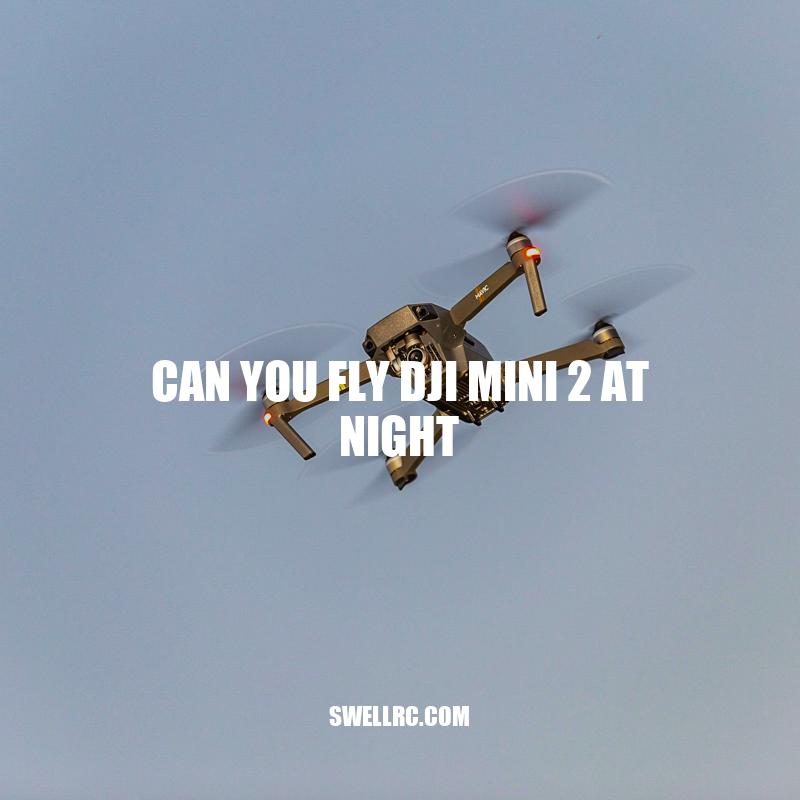Flying DJI Mini 2 at Night: Rules, Limitations, and Safety Tips
DJI Mini 2 is a popular drone choice due to its lightweight design, high-quality camera, and intelligent flight modes. As drone enthusiasts explore the possibilities of aerial photography and videography, the question of whether or not it is possible to fly DJI Mini 2 at night arises. While the drone’s camera is equipped with a high-sensitivity sensor capable of capturing clear images in low light conditions, there are rules and limitations that pilots must take into consideration when flying at night. This article will discuss the regulations related to flying drones at night, DJI Mini 2’s features and limitations when flying in low light, and the safety measures that pilots can take to ensure a safe and successful flight. By the end of this article, you will have a better understanding of what it takes to fly a DJI Mini 2 at night and the precautions to take to ensure a safe and enjoyable flying experience.
DJI Mini 2 and Night Flying Regulations
Before flying DJI Mini 2 at night, it is essential to understand the regulations and restrictions imposed by the Federal Aviation Administration (FAA). According to the FAA, drones must have anti-collision lights when flying after sunset to avoid collisions with other airborne objects. Here are a few regulations that pilots must follow in strict adherence to the FAA rules.
- Drones must have anti-collision lights visible from three miles away if they fly after sunset until sunrise.
- The drone must have a registered tail number with the FAA, and the FAA recognizes the drone with the registration number attached.
- The pilot must have a Remote Pilot Certificate (RPC), also known as Part 107, certifying the pilot has the knowledge required for flying drones legally in the US.
- It is always important to keep the drone within visible distance and avoid flying near airports or in restricted airspace.
As long as the pilot fulfills the FAA’s rules for drone flying, it is okay to fly DJI Mini 2 at night. After fulfilling the FAA’s requirements, pilots can move to the next step and understand DJI Mini 2’s capabilities and limitations for flying in low light settings.
When can you fly a drone beyond visual line of sight?
Unfortunately, flying a drone beyond visual line of sight (BVLOS) is illegal in most countries without special permission or a waiver from the aviation authority. The following are the situations where you may be allowed to fly a drone BVLOS:
- During military operations
- When conducting research for a university or other educational institution
- For conducting surveillance or other security activities for law enforcement agencies or commercial security companies
However, even in these situations, the operator must follow strict guidelines and regulations to ensure the safety of people and property. If you are interested in learning more about drone regulations in your country, you can visit the aviation authority’s website for more information.
Limits to DJI Mini 2’s Night Flying Capabilities
While DJI Mini 2 is equipped with features that make it suitable for low light conditions, it also has limitations that pilots must consider to avoid accidents. Here are some facts to help you understand DJI Mini 2’s limitations while flying at night.
| Limits | Details |
|---|---|
| Anti-Collision Lights |
|
| Visibility |
|
It is crucial to keep DJI Mini 2 in sight and avoid flying the drone in complete darkness to avoid losing control of the drone. It is also essential to keep the drone’s firmware and software updated and calibrate the drone’s sensors before flying it at night.
What are the limits on DJI Mavic Mini?
DJI Mavic Mini is a great drone for beginners and enthusiasts who want a compact and lightweight drone. However, there are certain limits to be aware of:
- Flight Time: DJI Mavic Mini has a maximum flight time of 30 minutes
- Wind Resistance: The drone is lightweight, making it less resistant to wind compared to other models in DJI’s lineup
- Range: The drone’s maximum range is 4km (CE) and 8km (FCC), which is less compared to DJI’s other models
- Camera Quality: While DJI Mavic Mini’s camera offers good quality, it has limitations like no 4K video recording and no obstacle avoidance sensors
It’s important to keep these limitations in mind when choosing DJI Mavic Mini for your aerial photography needs.
Tips for Safe Night Flying with DJI Mini 2
To ensure safe night flying with DJI Mini 2, here are some tips that pilots can follow:
1. Use Additional Lighting
Add extra lighting to increase visibility when flying DJI Mini 2 at night. The drone’s camera may struggle to capture images in low light settings, but additional lighting can help improve visibility and prevent accidents.
2. Check Weather Conditions
Before flying DJI Mini 2 at night, check the weather conditions to ensure that there is no chance of rain, thunderstorms, or strong winds. Poor weather conditions can make it difficult to control the drone, increasing the risk of accidents.
3. Practice Caution
When flying DJI Mini 2 at night, pilots should approach flying with extreme caution. Avoid flying the drone in areas with tall structures, electric power lines, or other obstacles that can obstruct visibility.
4. Follow FAA Regulations
Pilots must follow FAA regulations when flying DJI Mini 2 at night. The FAA requires drones to be equipped with anti-collision lights, so ensure that the drone meets these requirements before flying.
Conclusion
DJI Mini 2’s lightweight design, high-quality camera, and intelligent flight modes make it an excellent choice for drone pilots. While the drone can fly at night, pilots must consider the drone’s limitations and follow FAA regulations to ensure their safety and those around them. By taking the necessary precautions and following the tips outlined above, pilots can safely fly DJI Mini 2 at night and capture stunning aerial photos and videos.



